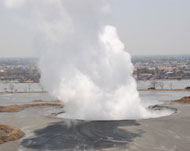Indonesia mud threatens environment
Indonesian plans to dump thousands of tonnes of mud, which has flooded an area about the size of Monaco, in a river and at sea, have been condemned by environmental groups.

Susilo Bambang Yudhoyono, the Indonesian president, has declared an area of Sidoarjo, East Java, swamped by mud a “disaster zone” and ordered that 3,000 families be permanently relocated.
More than 12,000 people have already been forced from their homes after mud, gas and boiling water started pouring out of the ground in May, submerging several villages and factories.
Engineers have tried to contain the sludge – which is as deep as five metres in some places – by building a series of dykes, but now the government is planning to channel it into a nearby river and the sea.
Nur Hidayaci, a campaigner with Greenpeace Southeast Asia in Indonesia, told Aljazeera that dumping the untreated mud could severely harm the environment.
“The coastal and marine ecosystem really will be damaged. I’m afraid that the impact will be irreversible,” she said.
Contamination
The mud will stop the sunlight from penetrating the water, killing plants, small organisms and severely damaging the flood chain.
Greenpeace also fears that the water tables in the area are at risk of toxic contamination.
 |
|
Mud started pouring from near |
Siti Maimunah, from the Indonesian mining watchdog Jatam, said the public needed more information about the risk of moving the mud to the sea.
“Stop fooling the public by saying there is nothing wrong with the mud. The massive volume in itself poses a huge risk to the environment and people’s health,” she said.
There are also fears that the situation will become much more dangerous when the rainy season begins in November.
Warning system
Hidayaci said Greenpeace “urges the government to put in place an early warning system for the people in the area as it is concerned that the dykes may collapse and turn the situation into a tragedy”.
|
|
On Monday, one of the sand and gravel barriers was breached injuring six workers and flooding an even greater area of land.
The mud started flowing on May 29 near an exploratory gas well that was being drilled by PT Lapindo Brantas.
There has been widespread speculation that the company – which is owned by the family of Aburizal Bakrie, the welfare minister – caused the disaster by failing to use a proper casing during drilling. Casings are used to contain fluids produced by the well.
Pumps and dykes
They have been ordered to pay at least 1.5 trillion rupiah ($164 million) for pumps and dykes to clear up the mess.
 |
|
There are concerns the mud will |
Geological experts have said it is impossible to prove conclusively that drilling was to blame for the disaster.
A geologist from the University of Oslo, Adriano Mazzini, said: “This is a huge case of overpressure.
“A casing would not have made any difference, I don’t think. But I’m not a drilling expert”.
Mazzini also said that the mudflow could be impossible to stop.
“It could be one, 10 or 100 years. But to seal it will be very, very difficult,” he said.